Visit the Museum of Cycladic Art in Athens to see the fantastic collection of prehistoric figurines, sculptures, and items from Ancient Greece and Cyprus.
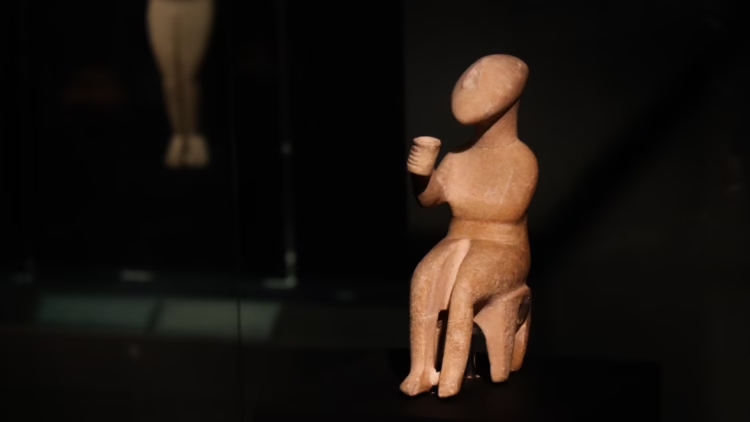
The main reason to visit the Museum of Cycladic Art in Athens is, of course, its fine collection of Cycladic art — the world’s largest private collection of these remarkable prehistoric sculptures. However, there is much more to see and enjoy in this remarkable museum. Ticket prices are €12 for the permanent exhibition.
Collections and Exhibition in the Cycladic Art Museum
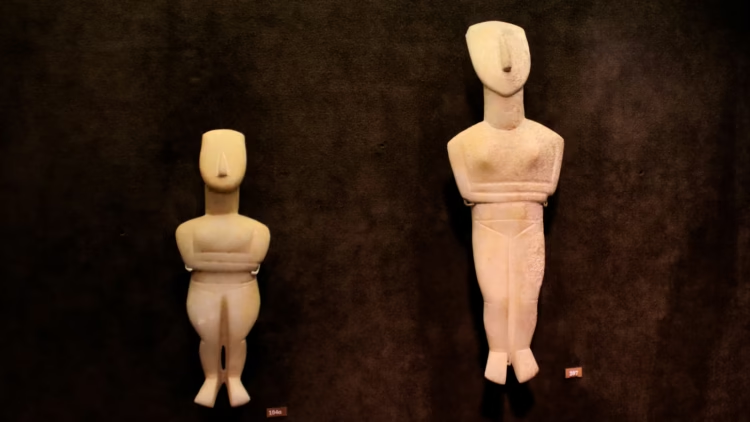
The exhibitions and collections of the Museum of Cycladic Art and Athens are displayed on separate floors as follows:
- Cycladic Art
- Ancient Greek Art — A History of Images
- Ancient Greek Art — Scenes from Daily Life
- Ancient Cypriot Art
- Special Temporary Exhibitions in the annex building
The Museum of Cycladic Art is one of the smaller museums in Athens that is absolutely worth a visit. It certainly is not the enormous collection of the magnificent National Archaeological Museum of Athens or the ultramodern and very busy Acropolis Museum, but the displays are interesting, well presented, and easy to enjoy.
Cycladic Art Exhibition
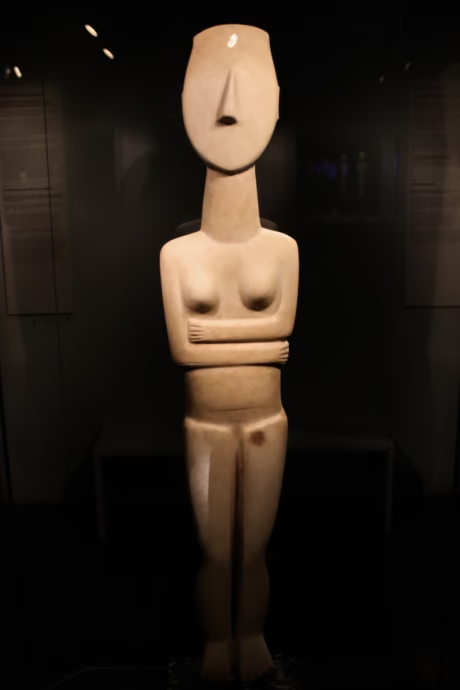
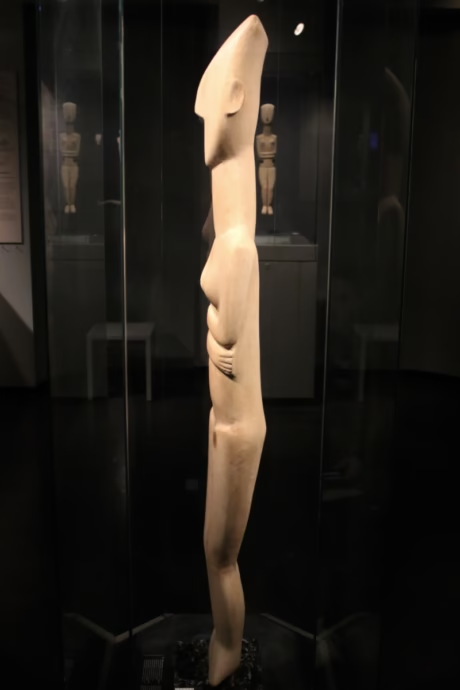
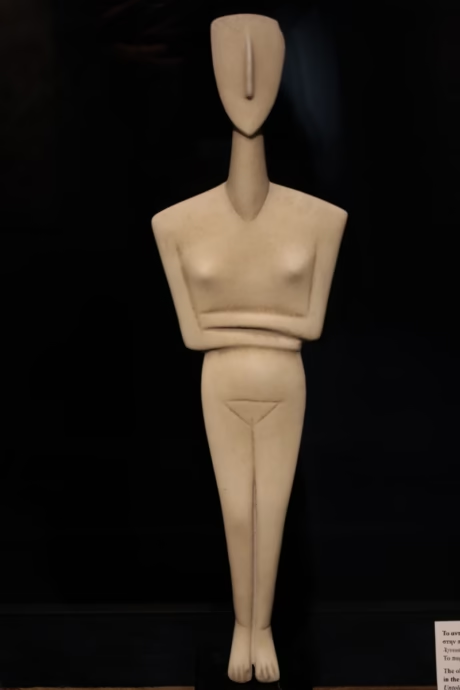
The exhibition of early Cycladic culture includes around 350 artworks and objects created around 3200 to 2000 BC on the 35 islands of the Cycladic archipelago.
Cycladic art is particularly associated with anthropomorphic marble figurines. Most of these are naked full-length females with folded arms. As with Classical Greek sculptures, these Cycladic figurines were originally painted but are now often admired for their beautiful minimalism.
The purpose and role of these prehistoric figurines remain uncertain. Although most were found in graves, they were not exclusively of funerary use.
The earliest figurines were carved from pebbles and are mostly violin-shaped. However, the most impressive works are the “canonical” types from the mature period (2700 to 2300 BC).
The mostly female naked standing figures have triangular heads, folded arms, and slightly bent knees. The archetypical figurine is a Dokathismata variety work (nr 206) attributed to the Asmolean Museum Master.
The largest figure in the museum is a 1.4 m tall female (but only 28 cm wide) of the Spedos variety. She was most likely used in public worship. (A slightly larger figure is in the National Archaeological Museum.)
Male and Genderless Cycladic Figures
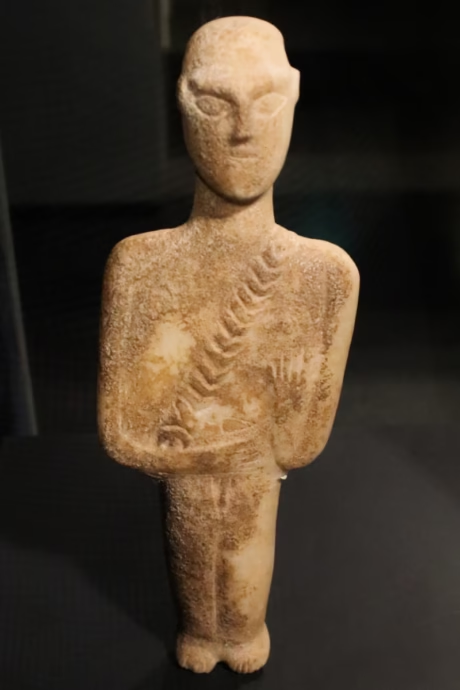
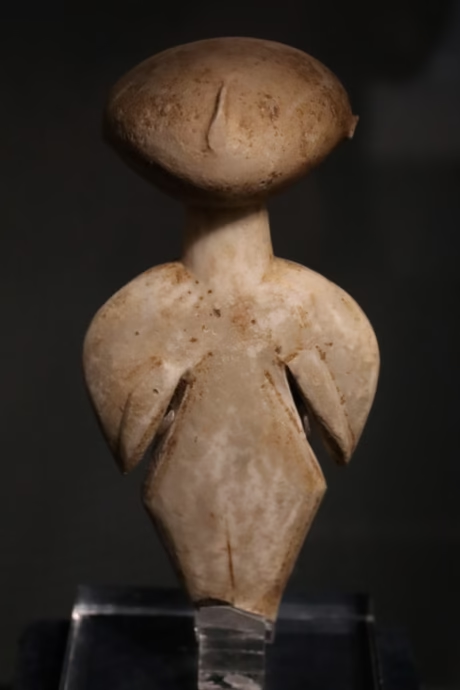
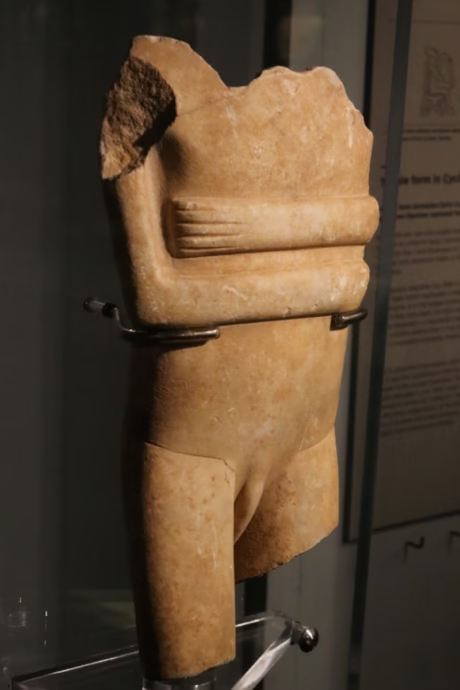
Most of the Cycladic figurines are female, but there are also some males. Only the torso survived of the only known large male sculpture from the period. The complete sculpture would have been around a meter tall and was probably displayed publicly like the large female sculpture.
In contrast to the static females, male sculptures (often with gender not specified) could be associated with action. A famous work has a seated figure raising a cup. (The National Archaeological Museum displays a couple of musicians.)
The Keros Hoard is a large collection of figurines and vessels seemingly deliberately fragmented as a ritual in antiquity rather than simple accidental damage.
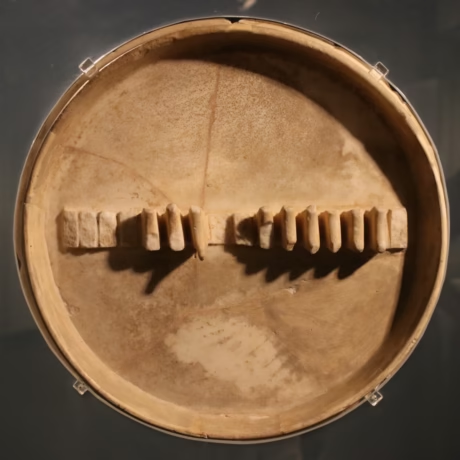
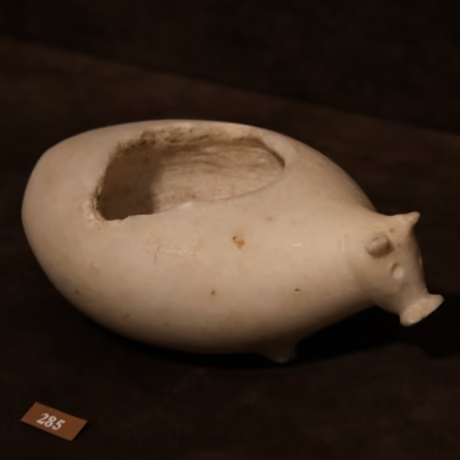

In addition to the figurines, the collection also includes tools, vases, pottery, and vessels. A particularly impressive item is the so-called Dove Vase. This large dish was carved from a single marble piece in the Syros phase (2800-2300 BC). It has a row of birds, probably doves, which made it impractical for use other than display or some ritual.
While the Cycladic islands clearly had the tools, material, and knowledge to produce weapons, these seemed to have been of lesser importance, especially compared to the Mycenaean and Minoan civilizations of the same period. This is particularly well illustrated in the National Museum of Archaeology in Athens, which has a large collection of items from all parts of Greece.
The Cycladic Art exhibition in the National Museum of Archaeology in Athens is very comprehensive and important. However, it is not as beautifully displayed or described as in this smaller museum. Few art lovers would regret visiting both museums.
Ancient Greek Art
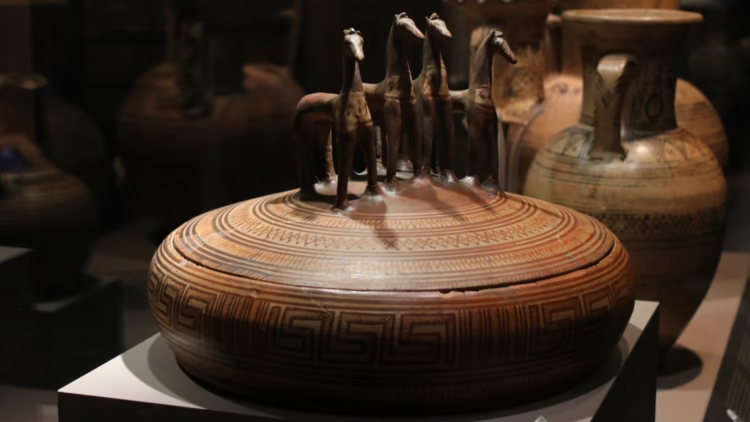
The museum’s Ancient Greek Art collection covers the period 2000 BC to the 4th century AD and is displayed in two exhibitions:
- A History of Images (on the second floor)
- Scenes from Daily Life in Antiquity (on the top floor)
A history of images explores how the social and political developments of the Greek civilizations influenced art and artistic expression. Around 400 vases, figurines, sculptures, jewelry, coins, and implements show how ancient Greek society functioned. Special displays focus on the role of women, the development of ancient Greek technology, and the influence of trade, war, and religion on art and design.
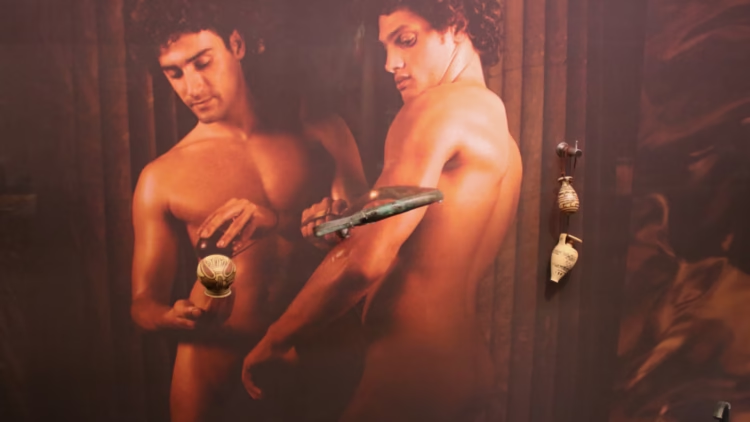
The special display of how many of the ancient items were used brings the daily life of ancient Greece to life. Familiar themes from antiquity include Gods and heroes, love and sex, toiletry and weddings, women’s activities (mostly restricted to the house), athletics, symposium, the Athenian Agora, warfare, death, and burial. A good summary of life in ancient Greece in 150 objects.
Ancient Cypriot Art
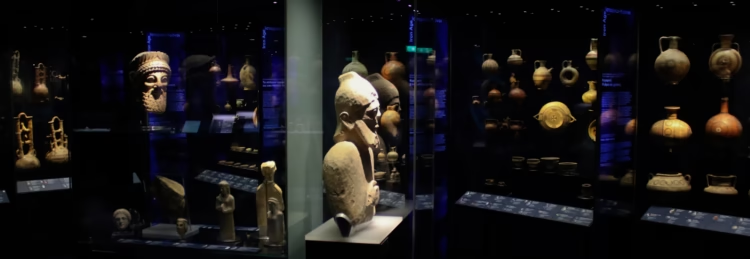
The collection of Ancient Cypriot Art is one of the most important outside Cyprus. It includes prehistoric figurines, Archaic and Classical sculptures, inscriptions, bronze objects, coins, impressive gold jewelry, glass objects, and various types of clay vessels dating from the 4th millennium BC to medieval times.
Highlights in the exhibition include pottery from the Early and Middle Bronze Ages with anthropomorphic and animal-shaped features, intricate double-neck jugs and figurines used for religious rituals, and a remarkable collection of glassware, small vessels, coins, and jewelry.
A special section deals with the development in the portrayal of humans. The Cypriot exchanges with ancient Egypt, the Near East, Greece, and the Eastern Mediterranean are reflected in the development of archaic sculptures that became increasingly detailed and realistic.
Visitor Information: Cycladic Art Museum in Athens

Opening Hours of the Museum of Cycladic Art
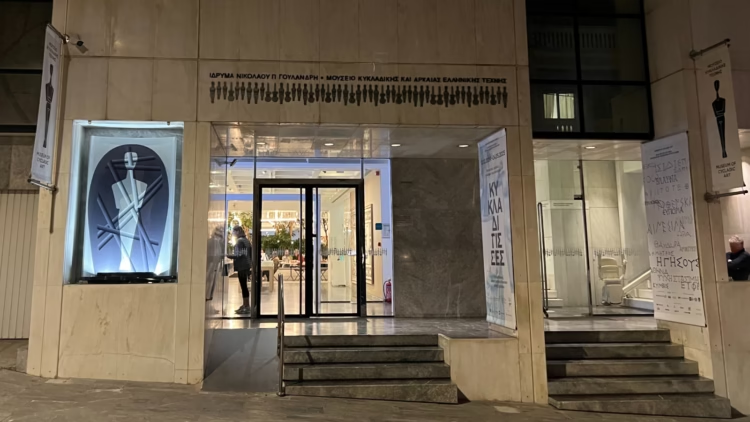
The Museum of Cycladic Art is open Wednesday to Monday from 10:00 to 17:00, but opens only at 11:00 on Sundays and stays open Thursday nights until 20:00.
The museum is closed on Tuesdays and many religious holidays.
Weekdays in the early morning and Thursday evenings are the best times to visit.
It is possible to visit the pleasant cafe and fine museum shop during the same opening hours and without a museum entry ticket.
Tickets for the Museum of Cycladic Art in Athens
Basic entry tickets to visit the Museum of Cycladic Art in Athens are €12 but frequent temporary exhibitions increase the price to around €18.
Discounted admission tickets for youths 19 to 25 and seniors over 65 years old are €9 (around €14 including temporary exhibitions).
Children younger than 18 years old enter for free.
Discounted tickets for the Museum of Cycladic Art in Athens are only available directly from the museum itself but the museum’s official website currently does not sell separate tickets for the permanent and temporary exhibitions. Tiqets and GetYourGuide sell permanent exhibitions tickets with time-slot reservations, and in contrast to the museum itself, tickets are available months in advance and even on the day of visit, if timeslots are still available.
Transportation to Visit the Museum of Cycladic Art in Athens
The main entrance to the Nicholas P. Goulandris Foundation – Museum of Cycladic Art (Μουσείο Κυκλαδικής τέχνης) is at Neophytou Douka 4, 106 74, Athens, just up the road from Leof. Vasilissis Sofias. It is usually also possible to enter via the Stathatos Mansion annex used for temporary exhibits at Irodotou.
The Museum of Cycladic Art is a pleasant 10-minute walk from either Syntagma or Evangelismos metro stations. Several buses stop nearby (but good luck working those out!)
More on Visiting Athens

- Acropolis & Parthenon:
- Acropolis Museum
- National Archaeological Museum of Athens:
- Ancient Agora — Archaeological Site and Museum
- 5-Day Combination Tickets — Worth it?
- Visit the Museum of Cycladic Art
- Cheap Public Transportation to Athens Airport — Bus X95 is cheapest, Metro M3 is fastest.
- Odysseus — the official website of the Ministry of Culture and Sports has better information than the very old-fashioned design.
Comments only appear after moderation. Name and email address are entirely optional.